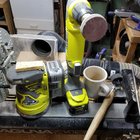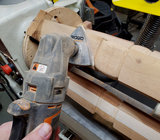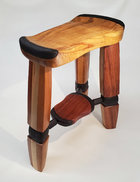I always wondered about interface pads on the Metabo or other random orbit sanders, especially soft pads. Won't they absorb the vibration energy and reduce the sanding efficiency?
-
November 2025 Turning Challenge: Wall Hanging! (click here for details) -
Congratulations to Craig Morton, People's Choice in the October 2025 Turning Challenge (click here for details) -
Congratulations to Andy Chen for "Mesquite Vase with Polymer Clay Millefiori" being selected as Turning of the Week for November 3, 2025 (click here for details) -
Welcome new registering member. Your username must be your real First and Last name (for example: John Doe). "Screen names" and "handles" are not allowed and your registration will be deleted if you don't use your real name. Also, do not use all caps nor all lower case.
You are using an out of date browser. It may not display this or other websites correctly.
You should upgrade or use an alternative browser.
You should upgrade or use an alternative browser.
Sanding tools
- Thread starter Emiliano Achaval
- Start date
I chose the cheap route for a power sander and bought a variable speed angle drill at Harbor Freight. I used it and liked it until one day I did some research on The Sanding Solution which is a passive sanding tool. I have found that sanding with this tool at each grit level is much quicker and it does a much better job for any single grit than power sanding in many cases. It doesn't, of course, serve all of my bowl and turning sanding needs, but most of them. I don't use my angle drill much at all now.
Olaf, I like that flex shaft you have, but consider the 1400 rpm to be too fast. Most of the time I am at half speed on my old Milwaukee/Sioux angle drills. Do you have any source for that shaft? I want to run one off of a mini lathe motor. Then mount that on that articulated arm I made for sanding...
I have found out that by running slower, like half speed, and using light pressure with my angle drills, the life expectancy at least doubled.
robo hippy
I have found out that by running slower, like half speed, and using light pressure with my angle drills, the life expectancy at least doubled.
robo hippy
An ancient thread, but renewed by others, so here's my collection of sanders for the lathe. That piece of sponge is my finger sanding tool. Yes, there is a tool in the group that is not for sanding, but I cannot sand without it.
The Word, according to Google is that alum is the gender neutral term for both fraternal and sororal. So, I learned two tings about gender equality today - the neutral for fraternal and that there is a feminine synonym for it as well as what that term is. Man, this place is making me smart.
The Word, according to Google is that alum is the gender neutral term for both fraternal and sororal. So, I learned two tings about gender equality today - the neutral for fraternal and that there is a feminine synonym for it as well as what that term is. Man, this place is making me smart.
Attachments
I have the Metabo, and the Grex...but this one is my favorite all around sander https://woodturnerswonders.com/coll...pro-mini-variable-speed-random-orbital-sander
I did play a bit with the ROS sanders, and impression was that they were fine for fine grits, like 220 and higher, but the angle drill was far better for coarser grits. I generally start sanding at 120. Some times I could start at higher grits, depending on wood, but most of the time starting a bit coarser saves me some time...
robo hippy
robo hippy
I use the Metabo with a soft interface pad and am very pleased with the result. But the oscillation destroys the interface quite quickly. It just shakes it to pieces, even at the minimum speed setting. I tried a 2” harder interface, but it shook it off the Velcro. The Metabo platen is too hard by itself, and too big for the inside of a bowl. There’s a gap in the market for a slow speed electric 2” ROS suitable for bowls. Or does someone know of one? My compressor couldn‘t run a pneumatic sander.I always wondered about interface pads on the Metabo or other random orbit sanders, especially soft pads. Won't they absorb the vibration energy and reduce the sanding efficiency?
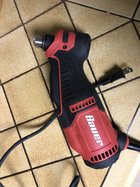
Our turning club has had no success with the WW sanders. I found this one at Harbor Frieght. 4 1/2 star rating and pretty heavy for a $50 close quarter. we will give it a good test on our four 2hp lathes used by our members. The black rubber acturally provides a better grip when sanding. will it standup. I‘lol report back in a couple months.
Brian Horais
In Memoriam
Many of my off-axis turnings require sanding with the lathe off. If I sanded the pieces while they are turning, the nice edges between surfaces would be rounded off. Here's a tool I have found useful for sanding these curved (but not round) surfaces with varying grits. It is an oscillating tool with a Velcro pad sanding attachment. Most of the time you see this tool used with various cutting attachments. The triangular pieces of sandpaper can be easily attached and with a variable speed tool, like the Rigid one shown here, it is possible to achieve a well controlled sanding process. This tool has been a major improvement over hand sanding, but is really useful only for those applications that can't be sanded with the lathe turning. The piece shown was a spindle turned on my therming rig and later used in the table shown in the second image.
Attachments
Last edited:
As near as I can tell, the two main killers of these angle drills, which we use more like grinders, are running at full speed, and pushing too hard on the wood when sanding. I did get some fancy sealed bearings for my drills, and they didn't seem to make any difference in longevity. Some make a point to blow out the inside of the case. I used to, but found out that didn't make much difference, at least not as far as I could tell. Brushes do wear out....
robo hippy
robo hippy
I'm curious what size/type compressor do you use w/ the pneumatic sander? Is it large *and* quiet? Where do you keep it?In the stable currently, is a Grex pneumatic RO sander, a new style Milwaukee, an old style Milwaukee, and a Sioux close quarters drill.
View attachment 21068 View attachment 21067
Though not using any sanding (or carving) air tools now, I wonder about them.
I've started my setup by using a Makita drill/driver w/ roloc discs (2" & 3" most often). I often prefer the padded inserts. Still figuring out when to use them or not.
Also use a Ridgid, corded ROS. I have a close quarters drill on order that's backordered a couple more weeks. I enjoy seeing and learning what others are using and for what applications.
Oh, I also ask about the compressor because I despise my small (6gal?) pancake air compressor as it takes me off guard and tends to blow my eardrums out if I'm not careful.
Nearly got one of these before ordering (still backordered) a WW one. Any specific issues you could mention?View attachment 38676
Our turning club has had no success with the WW sanders. I found this one at Harbor Frieght. 4 1/2 star rating and pretty heavy for a $50 close quarter. we will give it a good test on our four 2hp lathes used by our members. The black rubber acturally provides a better grip when sanding. will it standup. I‘lol report back in a couple months.
Odie
Panning for Montana gold, with Betsy, the mule!
Howdy Allen.....I'm curious what size/type compressor do you use w/ the pneumatic sander? Is it large *and* quiet? Where do you keep it?
Though not using any sanding (or carving) air tools now, I wonder about them.
I've started my setup by using a Makita drill/driver w/ roloc discs (2" & 3" most often). I often prefer the padded inserts. Still figuring out when to use them or not.
Also use a Ridgid, corded ROS. I have a close quarters drill on order that's backordered a couple more weeks. I enjoy seeing and learning what others are using and for what applications.
Oh, I also ask about the compressor because I despise my small (6gal?) pancake air compressor as it takes me off guard and tends to blow my eardrums out if I'm not careful.
I'm not using the Grex as much as I did a few years ago.....mainly because most of my random orbit sanding is done at the finest grits, and by hand. My opinion, is the RO is not needed until you get close to a finished surface that is ready to apply the finish.
My compressor is a 4hp 80gal tank Husky (Home Depot brand by Campbell Hausfield) Yes, it's pretty noisy, but being such a large tank, it doesn't start up that often. Many shops install their compressor in an attached shed and pipe in the air to cut down on the noise. I do use compressed air quite a bit for clearing away dust and chips. The compressor probably starts about once every one or two hours.
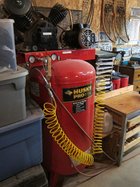
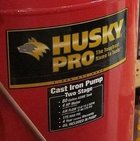
If your corded RO sander is working for you, that's probably the way to go.
Yes, I'm aware those pancake compressors can drive you nuts!
-----odie-----
I have a 20-gallon Sanborn (oil-less) 210psi compressor ... it has a hard time keeping up with my pneumatic sanders running at 90psi on the tool. I tend to run the tool in short bursts.
Have you considered adding another or larger tank? Or, maybe, upgrading to a 10 CFM compressor?I have a 20-gallon Sanborn (oil-less) 210psi compressor ... it has a hard time keeping up with my pneumatic sanders running at 90psi on the tool. I tend to run the tool in short bursts.
Maybe in the future ... too many other priorities right now.Have you considered adding another or larger tank? Or, maybe, upgrading to a 10 CFM compressor?

